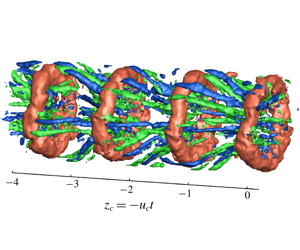Published online by Cambridge University Press: 06 February 2020

A possible interaction between vortical structures in a round jet shear layer, viz. vortex rings and streamwise vortices, is explored following Davoust et al. (J. Fluid Mech., vol. 709, 2012, pp. 408–444). These authors reported a radial organization of streamwise vorticity in a jet at high diameter-based Reynolds number ( $Re$), contrary to the classically observed azimuthal organization. They hypothesized that the observed weaker vortex rings in such jets could be deformed by streamwise vortices and further reoriented and stretched in the streamwise direction. As this hypothesis was based on the observations of one configuration of a jet flow, our study aims at assessing it by varying the key parameter, i.e. the relative strength of the vortex rings and the streamwise vortices, through forcing, along with various jet configurations. We first analyse a low-Mach-number,
$Re$), contrary to the classically observed azimuthal organization. They hypothesized that the observed weaker vortex rings in such jets could be deformed by streamwise vortices and further reoriented and stretched in the streamwise direction. As this hypothesis was based on the observations of one configuration of a jet flow, our study aims at assessing it by varying the key parameter, i.e. the relative strength of the vortex rings and the streamwise vortices, through forcing, along with various jet configurations. We first analyse a low-Mach-number,  $Re=1.5\times 10^{5}$ transitional jet, using high-speed stereo particle image velocimetry in a cross-sectional plane at two jet exit diameters from the nozzle exit. The axisymmetric mode is acoustically excited at various amplitudes to increase the strength of the rings relative to streamwise vortices, at a Strouhal number (
$Re=1.5\times 10^{5}$ transitional jet, using high-speed stereo particle image velocimetry in a cross-sectional plane at two jet exit diameters from the nozzle exit. The axisymmetric mode is acoustically excited at various amplitudes to increase the strength of the rings relative to streamwise vortices, at a Strouhal number ( $St$) of 0.49, the most energetic frequency in the unforced jet. Starting from a radial array in the unexcited jet, a gradual shift towards an azimuthal configuration is obtained with increasing excitation level. Quantification of the relative strengths of the streamwise vortices and vortex rings confirms that a radial array is observed whenever the streamwise vortices are more intense than the rings, and conversely for the azimuthal configuration. We then extend the analysis to other jet cases in terms of
$St$) of 0.49, the most energetic frequency in the unforced jet. Starting from a radial array in the unexcited jet, a gradual shift towards an azimuthal configuration is obtained with increasing excitation level. Quantification of the relative strengths of the streamwise vortices and vortex rings confirms that a radial array is observed whenever the streamwise vortices are more intense than the rings, and conversely for the azimuthal configuration. We then extend the analysis to other jet cases in terms of  $Re$,
$Re$,  $St$ and state of the exiting boundary layer. We observe that the correlation between the radial or azimuthal organization of streamwise vortices and the relative strengths of the vortical structures holds systematically, confirming the possibility of the proposed interaction. A detailed analysis of the forced jets also sheds light on some interesting effects of acoustic excitation on the vortical organization in round jets.
$St$ and state of the exiting boundary layer. We observe that the correlation between the radial or azimuthal organization of streamwise vortices and the relative strengths of the vortical structures holds systematically, confirming the possibility of the proposed interaction. A detailed analysis of the forced jets also sheds light on some interesting effects of acoustic excitation on the vortical organization in round jets.